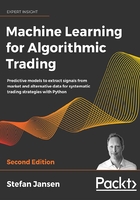
2 Market and Fundamental Data – Sources and Techniques
Data has always been an essential driver of trading, and traders have long made efforts to gain an advantage from access to superior information. These efforts date back at least to the rumors that the House of Rothschild benefited handsomely from bond purchases upon advance news about the British victory at Waterloo, which was carried by pigeons across the channel.
Today, investments in faster data access take the shape of the Go West consortium of leading high-frequency trading (HFT) firms that connects the Chicago Mercantile Exchange (CME) with Tokyo. The round-trip latency between the CME and the BATS (Better Alternative Trading System) exchanges in New York has dropped to close to the theoretical limit of eight milliseconds as traders compete to exploit arbitrage opportunities. At the same time, regulators and exchanges have started to introduce speed bumps that slow down trading to limit the adverse effects on competition of uneven access to information.
Traditionally, investors mostly relied on publicly available market and fundamental data. Efforts to create or acquire private datasets, for example, through proprietary surveys, were limited. Conventional strategies focus on equity fundamentals and build financial models on reported financials, possibly combined with industry or macro data to project earnings per share and stock prices. Alternatively, they leverage technical analysis to extract signals from market data using indicators computed from price and volume information.
Machine learning (ML) algorithms promise to exploit market and fundamental data more efficiently than human-defined rules and heuristics, particularly when combined with alternative data, which is the topic of the next chapter. We will illustrate how to apply ML algorithms ranging from linear models to recurrent neural networks (RNNs) to market and fundamental data and generate tradeable signals.
This chapter introduces market and fundamental data sources and explains how they reflect the environment in which they are created. The details of the trading environment matter not only for the proper interpretation of market data but also for the design and execution of your strategy and the implementation of realistic backtesting simulations.
We also illustrate how to access and work with trading and financial statement data from various sources using Python.
In particular, this chapter will cover the following topics:
- How market data reflects the structure of the trading environment
- Working with trade and quote data at minute frequency
- Reconstructing an order book from tick data using Nasdaq ITCH
- Summarizing tick data using various types of bars
- Working with eXtensible Business Reporting Language (XBRL)-encoded electronic filings
- Parsing and combining market and fundamental data to create a price-to-earnings (P/E) series
- How to access various market and fundamental data sources using Python
You can find the code samples for this chapter and links to additional resources in the corresponding directory of the GitHub repository. The notebooks include color versions of the images.